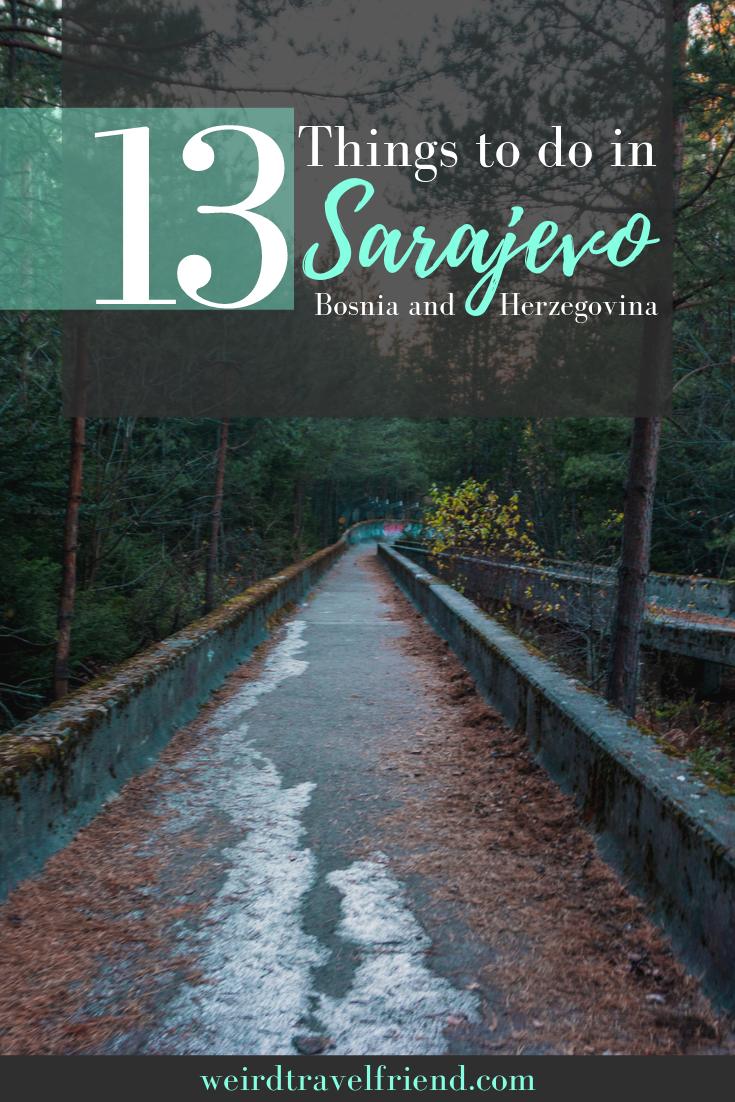13 Things to do in Sarajevo
/If you’ve ever been pleasantly surprised by a destination, you’ll understand what I mean when I say that I didn’t expect to like Sarajevo (and Bosnia in general) as much as I did. And no, my skepticism had nothing to do with my weird and traumatic bus ride in. I knew there was a lot of recent history I would learn about more in depth, but I had no idea just how much I would enjoy my limited time there. Sarajevo is truly a place I regret not booking off more time to explore. On the surface, preliminary searches of “things to do in Sarajevo” didn’t yield a ton of results outside of the typical museums and landmarks, so I’ll be sharing both a list of things that I did/saw and enjoyed as well as a few resources for planning your time in Sarajevo (kinda like I did with my post on Sibenik) - those will be at the bottom this write-up.
First things first: where I stayed
I stayed at the Franz Ferdinand Hostel right by the center of the tourist action by the Cathedral. I had booked it off the recommendation of someone I had met in Split and I really enjoyed y stay. The hostel has a great location, helpful staff, beds were comfortable and quite private for a hostel - and the free breakfast included eggs (which sometimes feels like a luxury item with free hostel breakfasts). Stay so centrally was great, but there were some good-looking options a little outside the center of action. My friend Kristin from How to Travel the Globe has been to Sarajevo a lot and wrote a great article about all the things to see, do, and eat in Sarajevo and you can check it out here.
A handful of things I saw/did on this list were during a couple tours with Spirit Tours Sarajevo. I’ll write a separate post about my experience with them, but know that my tours with them were not hosted.
Things to do in Sarajevo
Sarajevo Cathedral
Sarajevo Cathedral (whose real name is Sacred Heart Cathedral) is in the center of the action and is uniquely situated less than a 3-minute walk from a mosque, a former synagogue (now museum), and an Orthodox cathedral. The square out front is a common meeting place (particularly for free city walking tours). Sacred Heart Cathedral holds a lot of importance in the city. In fact it is so important to the city of Sarajevo that the design above the door appears on the Sarajevo Canton seal and flag and the bell towers can be seen on the Sarajevo coat of arms.
Sarajevo Roses
You’ll find these all over the city. Areas that had fallen under mortar attack during the war saw damage in the form of deep holes in the street pavement. Instead of filling them with asphalt, they were instead filled with a red resin to signify the bloodshed at each location. They may be easy to miss if you’re not paying attention, so keep a lookout.
Sarajevo Tunnel
Ok, so this may have been one of the most interesting things I did in Sarajevo, so I don’t want to ruin it by oversharing all the details here. Essentially, during the war the Serbs had Sarajevo surrounded on 3 sides, with the only area around the airport being open. The airport was taken over by the UN who were less than helpful in allowing Bosnians to bring aid into the entirely cut-off city (fresh produce, medical supplies, etc…). Tunnels were their creative—and lifesaving—idea to get around the UNhlepful.
Trebević
Talk about a beautiful viewpoint…. geez. From our vantage point, we had a view of the city along with the impressive mountain range in the distance.
Bobsled
This was also very cool. The abandoned bobsled (or… bobsleigh apparently?!) track from the 1984 winter Olympics is an interesting place to explore. We walked a section of the massive concrete track and it was covered in graffiti.
City Hall
This building was seriously put through the ringer. It was originally built between 1891 and 1894 - and if you guessed that it was destroyed during the war in the 1990s - you would be correct. It took the city a long time and a lot of generous support by different countries and cities, but the reconstruction was finally completed and building reopened in 2014.
I took what I think is a really interesting photo (though I certainly wouldn’t call it beautiful) when I was looking at the block around the building – so click on the image below and read the full photo caption.
Latin Bridge / Franz Ferdinand Assassination Site
The assassination of Archduke Franz Ferdinand was what kicked off the first World War, but it almost didn’t happen. There were several men along the Archduke’s driving route that intended to kill him, but the first never deployed his grenade. The second threw it but had bad aim and the grenade bounced off the back of the car, and instead badly injured some of Ferdinand’s entourage in the car behind. Since he botched the attempt, the would-be assassin jumped in the river to try to kill himself buuuut that happened to be only a few centimeters deep that day. Whoopsie.
Ferdinand goes to the hospital to see his injured friends and Gavrilo Princip goes to sulk in a café to be a little whineyboy about missing his attempt to, ya know, murder someone. As he’s leaving the café, Ferdinand’s car passes by, stalls out while trying to reverse and Princip opened the car door and shot both the Archduke and his wife. Depending on who you ask, Gavrilo Princip was either a murderer or a hero.
Gazi Husrev-beg Mosque
The Gazi Husrev-beg Mosque was built in the 16th century and is a good example of Ottoman architecture. One interesting note about the location is that it sits just to one side of a "border" (noted with an inlay on the pedestrian walkway) between the "east" and "west" influenced parts of the neighborhood. When you cross the line you're moving between the more Austro-Hungarian influenced architecture, and the more Ottoman-influenced architecture.
Gazi Husrev-beg was the man who funded the building of the mosque (and had a hand in building other infrastructure within the city). Apparently he also had the first public toilet built just outside the mosque's courtyard.
Tašlihan
I don't know why I was surprised, but coming across ruins in the middle of Sarajevo threw me a little. They're the remnants of the Tašlihan- a big building that was used to house entire visiting caravans (so instead of needing to take everything off your horses and carts, the space is big enough to fit everything and operate as a showcase for their goods). The original structure went up between 1540 and 1543, and was funded by Gazi Husrev-beg... who you’ll recall from the section above was also the force behind creating the mosque in the background of the photo (you can see the white and gray minaret).
Toilet
This was one of the more surprising things I learned while in Sarajevo. The toilet can be found alongside the Gazi Husrev-Beg Mosque (a beautiful, historic building in the center of Sarajevo’s bustling downtown district). The true reason for the construction of the toilet is unconfirmed, but the speculation is that because of the cleanliness requirements of the Islamic faith. The men working on the mosque construction project needed to have a dedicated place to use the bathroom. The toilet is in operation today (after a brief closure during the war in the 1990s).
Clock Tower
Clock towers in general are varying degrees of interesting, but this one is a one-of-a-kind. Looking at Sarajevo Clock Tower some visitors assume the clock is broken because the hand placement looks off. Every public clock in the world is set to the solar calendar (time is measured by earth’s rotation around the sun) - and this is the only clock in the world (or only one public clock, at least) that is set using lunar time. The lunar calendar uses the moons rotations around the earth as their time measurement. The clock’s time is adjusted twice each week to ensure that the clock notes a firm 12:00 at sunset.
Meeting of Cultures
Sarajevo has existed under several different empires of differing cultural influence, but the two most influential in the shaping of the city and local culture, are the Ottoman and Austro-Hungarian periods. This spot is the very literal line where the two cultures meet – and there is a clear and definite shift in feel between the two. On one side of the street, you’ll see lots of modern-feeling architecture with hints of Austro-Hungarian neo-gothic peeking through in various buildings. At a certain point, you’ll notice the buildings get shorter and browner.
When facing east (towards the Ottoman side), look left and you see a little rotating sign you can spin to decide which section to explore first! Next to that sign is an informational poster about both the eastern and eastern halves.
Sarajevo Haggadah
Ok this was seriously interesting. You know how sometimes you’ll visit a place that you don’t know much about and have your mind completely blown when you learn about something that happened there? I had a lot of moments like that in Bosnia in general, but the story of the Haggadah probably ranks top. I’m not going to give too much away, but basically it’s a sacred Jewish text that made its way to Sarajevo, lived in a temple, then lived in a museum, then was almost stolen by the Nazis for a weird collection Hitler was putting together, but saved by a Muslim man named Derviš Korkut (who has a craaaazy interesting history), almost stolen again, and then locked down in a museum. Even if you’re not a keen on books, this one is incredibly special and worthy of a new Indiana Jones movie.
The Haggadah can only be seen Tuesdays and Thursdays (and the first Saturday of each month) from 12pm-1pm. I believe that this is for the sake of preservation.
So when are you going?!
I really, really enjoyed my time in Sarjevo (and as you'll read later, in Mostar as well) and feel really strongly that it's a place that should be on people's "to visit" lists. If you're reading this, I would imagine that you've already booked your trip or are thinking about it. I have the greatest affinity for places where I learn something new. In Sarajevo, I felt like every waking hour was another fact or cultural difference absorbed. Further, Sarajevo (a bit more than other areas in BiH) is pretty well set up for tourism, so an influx in visitors won't have an immediate negative impact. I know that may be a weird way to sign-off a blog post, but whatever... the idea of over-tourism has been on my mind a lot and I figured it was worth sharing. Okhthatstheendbyeee!
Here are a few extra resources when you're planning out your time in Sarajevo!:
Atlas Obscura's 13 Cool, hidden, and unusual things to do in Bosnia and Herzegovina
Travel Elsewhere 6 Reasons to Visit Sarajevo
Big World Small Pockets 15 Cheap Things to do in Sarajevo
What has been a place you didn't expect to love, but did?
What is the most shocking fact you've learned about a place you've visited?
How do you figure out your itinerary for places that don't have a ton of trip-planning literature on the internet?








